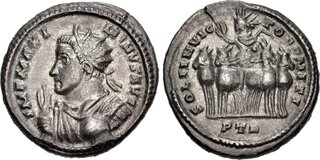| Classical Numismatic Group > Electronic Auction 552 | Auction date: 13 December 2023 |
| Lot number: 591 Price realized: 550 USD (Approx. 510 EUR) Note: Prices do not include buyer's fees. | Show similar lots on CoinArchives Find similar lots in upcoming auctions on |
| Lot description: Maximinus II. AD 310-313. "BI Pseudo-Argenteus" – Follis (18mm, 2.91 g, 12h). Treveri (Trier) mint, 1st officina. Radiate, draped, and cuirassed half-length bust left, raising hand and holding globe / Sol driving facing quadriga, head left, raising hand and holding globe and whip; PTR. RIC VI 826; RSC 174. Toned partial silvering amd brown patina, minor flan crack, light cleaning scratches. VF. From the Quietus Collection. Ex Nomisma S.p.a E-Auction 8 (27 January 2019), lot 176. The curious sometimes titled 'pseudo-argentei' or 'billon-siliquae' of Treveri (Trier) present an interesting anomaly within early 4th century Imperial coinage. Issued only at Trier, there are three types within this series that correspond to the three rulers between AD 310-313: Constantine I, Licinius I, and Maximinus II Daia. Dr. Bruun et al in RIC VII (1966) attributed the issues of Constantine and Licinius to 318-9 while Sutherland et al conversely attributed those of Licinius and Maximinus to 310-313 in RIC VI (1967). Given that there is an example from this series of Maximinus II as Augustus (310-313), the earlier date of 310-313 is preferable. This assumes, however, that these three issues are indeed from the same series. For clarity, the coins of the series specifically in question are as follows: Constantine I, RIC VII 208A; Licinius I, RIC VI 825 VI = RIC VII 211-212; and Maximinus II, RIC VI 826. Given this background, the issue of what exactly these coins represent denominationally remains to be unpacked. Easily dismissible from any serious discussion is the 'billon-siliquae' phraseology. The siliqua was not introduced as a denominational replacement for the argenteus (itself a replacement for the denarius) until Constantine's monetary reforms of 324. Consequently, any reference to these coins as being derivative of the siliqua is extraneous. Perhaps more valid is the sometimes-employed wording of the 'pseudo-argenteus.' Indeed, the argenteus was the silver denomination of the Tetrarchy which immediately preceded the time in question of 310-313. Thus, using its phraseology to help describe the curious phenomena encountered in these coins makes some sense. However, simply calling them pseudo-argentei makes assumptions about the successor to the argentus between the time of its discontinuation at Trier in 310 and before the introduction of the later silver denominations of Constantine – conventionally titled the siliqua and miliarense. As such, what exactly these coins represented as circulating currency and were valued at is difficult to say. In the intervening period between the Argenteus' discontinuation and the introduction of new silver denominations in Constantine's later currency reforms, the question is begged as to what denomination was held as the median coin between the highly valued aureus and the much lower valued follis. Ultimately, future more research may uncover this missing link, if indeed there was a median denomination at the time. Alternatively, as seen in the fallout from Diocletian's 301 edict on maximum prices, the Roman public may have simply generally ignored the central government's directives and efforts to preserve its currency standards by largely resorting to localized barter methods. But this hypothesis still fails to explain what could be represented by these so-called "pseudo-argentei," many of which seem to feature a noticeably higher silver content than other folles. However, other examples, apparently from this same series, feature lower silver content more in-line with the silver wash treatment that folles received of approximately 2-5%. Could it be that perhaps only the early issues of this series at Trier were given this higher silver content "billon-treatment." If so, what was the purpose and reasoning behind the decision to seemingly release these coins at a higher silver content before abandoning the technique? The answers to these questions are perhaps unlikely to become apparent without additional research into the monetary system of 301/10-324. In the meantime, this interesting series provides an area for further research for those intrigued by the changes in the Roman monetary system between Diocletian's efforts to stabilize and rebalance monetary policy, and the later reforms of Constantine I following his triumph over Licinius I. Estimate: 100 USD |  |



